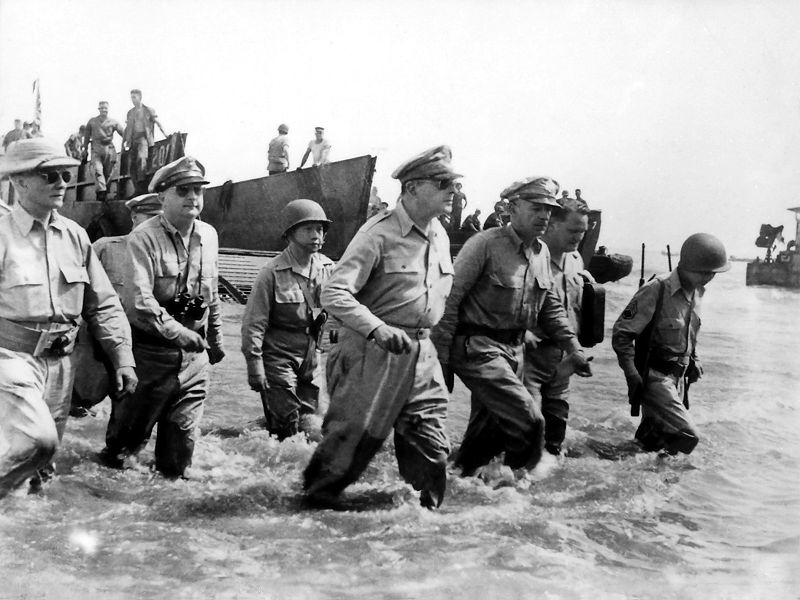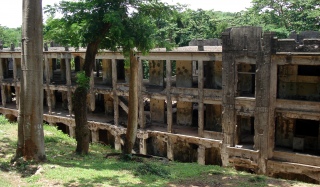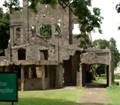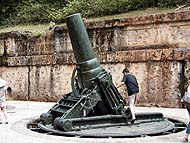![]()
"I Shall Return"...
The story of an exciting visit to the famous island Corrigidor, 26 miles off Manila. Also known as the island where the American General MacArthur had to escape from the Japanese troops in 1942 and said the famous words: " I shall return "before he boarded his boat and in haste left the island, while the Japanese troop units approached dangerously.
By Kim Frost Fuglsang
It was early in the day .. VERY early. My taxi was ready in front of the hotel and was waited while I, as the only guest in the breakfast restaurant forced down a
piece of bread and a cup of hot tea.. at this ungodly time. I nodded kind ly to the lone waiter and hankede up in my backpack with the most essential necessities and hurried out to the waiting cab. It was overcast and a bit windy. One felt clearly that it was a public holiday in Manila as the streets were not so busy as on other mornings. The town was not quite awake yet. It was only 5:30 and I still felt the sleep in my body. I leaned back in the taxi and closed my eyes and tried to take a nap during the approximately 1 hour long drive, while I tried to imagine what was awaiting me on the 1 day's outing. Corrigidor, known for the fierce fighting between Allied forces and fanatical Japanese during the last war. ly to the lone waiter and hankede up in my backpack with the most essential necessities and hurried out to the waiting cab. It was overcast and a bit windy. One felt clearly that it was a public holiday in Manila as the streets were not so busy as on other mornings. The town was not quite awake yet. It was only 5:30 and I still felt the sleep in my body. I leaned back in the taxi and closed my eyes and tried to take a nap during the approximately 1 hour long drive, while I tried to imagine what was awaiting me on the 1 day's outing. Corrigidor, known for the fierce fighting between Allied forces and fanatical Japanese during the last war.
I was on one of my numerous travels around the world to on behalf of my company. This time I had 2 days off during the stay and decided to use one day for a solid game shopping for my family and the other day for something culturally. My sweet Filipino colleagues had previously taken me out to the large American military cemeteries in Manila. These are just as touching and thought-provoking as the major cemeteries in Normandy.
Because one of these days was a public holiday shopping was not an option. So it would obviously be a cultural experience. My colleagues, who know my great interest in World War II, suggested that I went on a day trip to the island Corrigidor, located approximately 26 miles outside of Manila. I thought it sounded like a great idea. I had previously read about the hard-fighting, first with Japan as the great agressor and later as "pay back" by the American forces where it was the Japanese forces that had to give up on the same island.
" We are here Mister " ... I woke abruptly when the taxi pulled up in front of the small port terminal. Port terminal was maybe a big word .. It was merely a small building with small hatches and waiting room consisting of uncomfortable plastic chairs in an air-conditioned room with a large fan in the ceiling that ran fiercely round even though it was neither hot or humid this early in the morning.
After having downloaded and paid for my ferry ticket and experienced the common Philippine bureaucracy with punches and control and then check again, I sat now and waited along with about 15 other passengers, of which, besides me, was an Italian and German couple and a group of older Philippine men and what could be their children and grandchildren.
After about 20 minutes we were called out to the small high-speed ferry, which had been based just outside the "port terminal." After having our tickets checked again we all went aboard and found us some proper seats with a view. Aboard the ferry were 4 armed guards, which surprised me a little. 4 The guards were armed with modern assault rifles, pump guns, heavy guns and bulletproof vests. I asked one of the other passengers why we had armed guards. He told me that "it was as a protection against pirates who roamed the waters we were going through during the approximately 2 hour long sailing."
"Approximately 2 hour sailing???” I had naturally freshened the story about Corrigidor up but had not investigated the sailing time to the island. 2 hours on a ferry the size of the Copenhagen harbor buses in the pirate-filled waters. Cosy! Normally not a problem on a windless day, although I do from time to time suffer from motion sickness if to rough seas and it was now beginning to become a bit windy and the sea began to bare its teeth. And if that was not enough, it was also started to drizzle. Well, nevermind. I had to find me a suitable place and then just close my eyes and take it as an experience.
After something feeling as an eternity ... a scratchy loudspeaker announced that we would call at the island in about 20 minutes. I went outside on the small deck to take some good pictures of the little island when we approached. The weather had cleared up a bit and it was part warmer now and then it had fortunately stopped raining.

The island was characterized by a large and steep hill around the middle of the main island, which in spite of a green and lush cover of lush vegetation looked very rocky and rugged out. The island looked almost as if it had been torn apart without completely going in 2 pieces. The island was therefore associated with a low area between the 2 main islands, one of which was therefore marked by a high mountain.
Down at the pier we were greeted by our guide who at the same time would be our driver at these strange small open buses that would take us around the island. The island measures approx. 9 square miles and was originally used by the Spaniards as prisoner island. After the Americans invaded and drove out the Spaniards, they turned it into a fortification island. The original road from before 1945 has been restored after the island had been more or less leveled from the heavy bombardements.
 " All on Board " - shouted the driver finally after havinga frivolous talk with the 4 security guards. We found us a suitable place in this strange vehicle, most of all resembled a cross between a tourist bus in Universal studios and a streetcar in San Francisco and is supposed to look like the streetcars that connected the island with rails allowing the tramps to go around the island and be a convenient mean of transport for the many troops. The rail network was established back in 1930 and created an efficient transport network for the many people who were stationed on the island. " All on Board " - shouted the driver finally after havinga frivolous talk with the 4 security guards. We found us a suitable place in this strange vehicle, most of all resembled a cross between a tourist bus in Universal studios and a streetcar in San Francisco and is supposed to look like the streetcars that connected the island with rails allowing the tramps to go around the island and be a convenient mean of transport for the many troops. The rail network was established back in 1930 and created an efficient transport network for the many people who were stationed on the island.
We started our trip while the driver gave us a basic briefing about the island's historical significance and how the American troops had established them selves as a quite small community of military barracks, offices, cinemas, shops, etc. It was not that often you got a LeavePass to sail in to Manila, so they tried instead to ensure that all soldiers under their Leave on the island, could pass the time in a sensible manner. All the young men, should find themselves comfortable and be able to endure being stationed far from home.
As mentioned, there island still show signs from having been under massive bombardment, although it is maintained in a whimsical way ... almost like a war memorial of some of the toughest battles in the region. First as a heavy bombardment of the Japanese in 1942 and later by the Americans in 1945 when they conquered the island back from the Japanese.
It looks very surealistsk with all the many empty skeletons from the buildings that were damaged during the many bombardments. They stand still, as then, though overgrown with woods and vines and kept as it looked in 1945 with bomb craters and damaged guns and mortars. Virtually no building stands today as before 1942. It is both touching and shocking to see the empty shells of what was formerly a well working military installation with thousands of American troops.
I visited the former movie theater - a natural gathering point for the many young American men far from home. One senses clearly that it has been a major cinema, with ticket sales, kiosk, bar and balcony. Today it stands as an empty shell without content, and only your imagination can provide a picture of how it looked when the war had not yet reached Corrigidor. You can imagine the long queues of soldiers at the ticket office full of expectations for the movie they were to see while shouting at each other, buying pop corn together with the other playful young expatriate soldiers. This was a central place where the young soldiers' thoughts were diverted from their deprivation. Thoughts of war had not reached the island at that time in 1939-1940. It was still a distant time and certainly not something you thought about when you were only in their early twenties and full of youthful daring.
 Located on the island the American troops in 1920 dug a deep tunnel system into the mountain where they had originally ammunition depots, and later changed to emergency hospital and headquarters during a possible bombardment. Located on the island the American troops in 1920 dug a deep tunnel system into the mountain where they had originally ammunition depots, and later changed to emergency hospital and headquarters during a possible bombardment.
Today you can take a guided tour through through the tunnels where you can see and hear how a bombardment has felt like. This is demonstrated with sound and light show and is certainly a different and provoking experience. The tunnel system is very extensive and unfortunately it is only some part of it that is open today, intact and safe to move around in.
Since the Japanese in 1942 had moved into the region and threatened the U.S. and Philippine army the island eventually was subject to a lame-hitting barrage of the Japanese.
During one of these heavy bombardment General MacArthur was about to lose his live when a shell hit his headquarters just as he had stepped out of the building. The building, or rather skeleton, still standing and shows clearly where the grenade has gone down. The Japanese had gathered very precise information about the American interior of the island, evidenced by the first shell that struck the island hit accurately into the Commander's headquarters. No coincidence, and this time the Americans had still a very ambivalent relationship to intelligence and had a naive belief that there were not spied against the United States.
 One of the major installations on the island is the giant of mortars and gun sites. These were to defend the island against a direct attack and landing from the sea. Of Large Motars and the guns were the "12 inchs Coastal Guns." A whopping 56 of them and quite advanced for the time, elevation guns, so it would be difficult for an enemy to spot where the gun positions were located as they only came up over the edge when the grenade was fired, except if the enemy already knew where they were placed. Another problem was that if the enemy had first come ashore the canons and large mortars were useless as they could not be used against intruders already on the island. One of the major installations on the island is the giant of mortars and gun sites. These were to defend the island against a direct attack and landing from the sea. Of Large Motars and the guns were the "12 inchs Coastal Guns." A whopping 56 of them and quite advanced for the time, elevation guns, so it would be difficult for an enemy to spot where the gun positions were located as they only came up over the edge when the grenade was fired, except if the enemy already knew where they were placed. Another problem was that if the enemy had first come ashore the canons and large mortars were useless as they could not be used against intruders already on the island.
This meant that when the Japanese first came ashore on the island, they could only defend themselves with light weapons in the terrain, which was a tough nut to crack against the fanatical Japanese.
Today the big guns and mortar appear with split race or destroyed otherwise ... as they were often destroyed by soldiers from the American artillery units before they were captured or had surrendered to the Japanese troops so that they could not be used against the Allied during a future re- attack on the island.
As mentioned earlier, General MacArthur had in 1942 left the island in great haste when the Japanese after a heavy bombardment had landed troops on the island. A larger number of American troops were prevented from leaving the island and had to seek shelter from the previously mentioned tunnel systems.
And it was during the evacuation from the island before sailing General MacArthur said the famous words, "I shall return." Today there is a statue erected of the General at the very spot where he went in the boat and left the island.
Subsequently they last remaining troops eventually surrendered to the Japanese troops and had to live through war captivity all sorts of torments under the sadistic Japanese victorious infamous propensities, which in many ways surpasses any normal sense. Not many POWs survived the approximately 3 years in captivity.
Corrigidor is today a "groomed" island with fine roads that connect the whole island's historic areas. Above the little harbor is a tourist and souvenir shop and a restaurant where one of the packaged tours offers a meal, while you can gaze out over the island and among other things see the entrance to the a forementioned tunnel systems, also officially known as the "Malinta Tunnel" or colloquially, "MacArthur's tunnel."
A little exciting anektdote around the island ... In the mid 1980s there was an American amateur archaeologist and history of interest that had been allowed to dig a little into the ground on the island to find a layer of debris after the turbulent actions. During these excavations he found the remains of Japanese army units. That is, the remains of Japanese soldiers who had been buried in haste or simply abandoned and covered with a thin layer of soil. As the years went close bush grew up in a place where a Japanese artillery unit had been located and knocked out early in the battle in 1945.
A decision was extraordinary and contrary to custom, the Japanese decided to establish a Japanese cemetery and memorial to those Japanese soldiers in the same place, although one from the Japanese side has always taken pains to get all dead soldiers back home to Japan to be laid to rest In his country's soil. This in itself is remarkable because nowhere else in the world today, the Japanese have wanted to establish a cemetery outside of japan.
Towards evening, after a long day with lots of new and exciting experiences, it was again time to sail back to Manila. There was a strange silence during the ride on the ferry. You could only hear the 4 guards who spoke softly and the ferry's engine humming.
Specifically, I noticed the old Filipino men who had taken the trip to the island together with their sons and grandsons ... They sat alone on their own and looked with empty eyes out in nowhere while their children and grandchildren stood outside on the deck and had a good time out on deck in evening sun. Age matched very well with that they could have been children or adolescents in 1945 and no doubt had some memories and traumatic experiences to carry around.
|